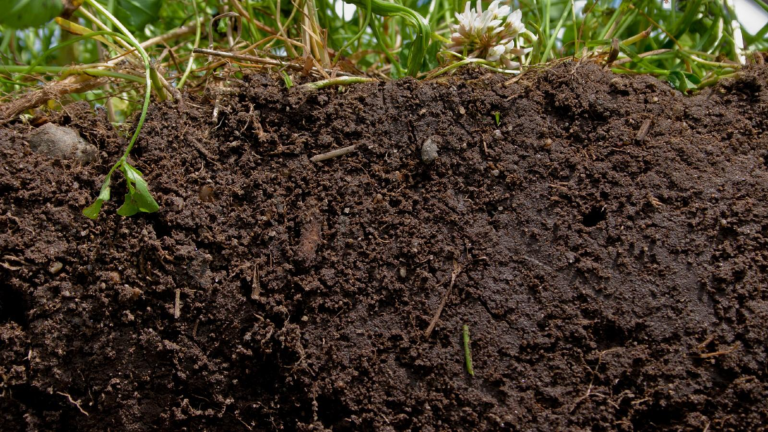I used to wonder why my lawn stayed patchy and full of puddles, even after watering and seeding. No matter what I did, the grass wouldn’t grow thick. Then I learned the problem wasn’t the grass—it was the clay soil.
Clay soil feels sticky and heavy. Water can’t soak in well, and roots struggle to grow. It can be as hard as rock when dry and as soggy as mud when wet. That’s tough on any lawn.
The good news is you can fix clay soil without too much trouble. It just takes a few steps and some care. In this blog, I’ll show you how to loosen clay soil, add the right materials, and help your grass grow strong. You don’t need fancy tools or big words, just a little time and some simple tips that really work. Let’s get started.
Why Clay Soil Makes It Hard to Grow a Good Lawn
Working with clay soil can be challenging. It feels heavy and sticky when wet. When it dries, it turns hard and cracks. This kind of soil holds too much water and doesn’t let in enough air. Grassroots have a hard time pushing through it. They don’t get the air, water, and space they need to grow.
Because of this, lawns with clay soil often look patchy, soggy, or thin. You may notice puddles after it rains or dry, cracked spots during hot days. The ground can feel hard under your feet. This type of soil can stress your grass and increase its susceptibility to die during periods of heat, cold, or drought.
However, the good news is that clay soil can be improved. With the right steps, you can turn clay soil into healthy soil that supports thick, green grass.
How to Tell If You Have Clay Soil
The best way to fix clay soil is to identify it accurately. You can tell by how the soil feels and looks. Grab a handful of damp soil from your yard. Roll it in your hand like dough. If it forms a tight ball and feels smooth and sticky, you likely have clay soil.
Other signs of clay soil include:
-
Water is pooling or running off instead of soaking in
-
Soil that sticks to your shovel or tools
-
Hard ground that cracks when dry
-
Poor grass growth or weak root systems
-
A lawn that stays wet or soggy for too long
If these sound familiar, you’re probably dealing with clay soil. But don’t worry. You can still grow a beautiful lawn with the right plan.
Best Ways to Fix Clay Soil in Your Lawn
These easy steps can help turn hard, sticky clay into soft, healthy soil. With time and care, your lawn will grow stronger.
1. Improve Clay Soil One Step at a Time
Fixing clay soil takes time, but you don’t need to do it all at once. Start with small steps and add more each season. As your soil improves, so will your grass. You’ll notice better drainage, stronger roots, and greener lawns over time.
Below are the best ways to improve clay soil and help your lawn grow.
2. Start by Aerating the Lawn to Break Up Compacted Soil
Aerating means punching small holes into the soil. This helps break up the tight clay and lets air and water move into the ground. It also helps grassroots grow deeper.
You can rent a core aerator from a garden center or hire someone to do it. A core aerator removes small plugs of soil from the lawn. These holes give roots room to grow. It also makes it easier to add soil amendments later.
The best time to aerate is in the spring or early fall when the soil is moist and the grass is growing. Avoid doing it in the summer heat or when the ground is too wet or dry.
3. Add Compost to Feed the Soil and Improve Structure
Compost is one of the best things you can add to clay soil. It’s made from broken-down food, leaves, and grass. Compost feeds the soil and helps loosen up the heavy clay.
Spread a layer of compost—about half an inch to one inch—over your lawn after aerating. Then rake it in so it falls into the holes and mixes with the clay. Compost adds life to the soil and helps grass grow better.
You can repeat this every spring or fall to change the soil over time slowly. Each layer of compost helps make the soil richer, softer, and more workable.
4. Use Gypsum to Help Clay Break Apart Faster
Gypsum is a natural mineral that helps clay soil become less sticky. It works by breaking up the tight bonds between the clay particles. This lets more air and water get into the soil.
You can buy gypsum at garden centers. Spread it over your lawn using a broadcast spreader, then water it in. Gypsum doesn’t change your soil’s pH, so it’s safe to use with most lawns.
Gypsum doesn’t work overnight, but it can help a lot over time, especially when used along with compost and aeration.
5. Topdress With Sand and Soil Mix Carefully
Some people think sand alone will fix clay soil, but that can actually make things worse. Adding only sand to clay can create a mix like concrete—hard and tight.
Instead, use a mix of sand, compost, and topsoil. This helps improve texture and keeps the soil loose. Spread this mix in a thin layer over the lawn after aerating. Rake it into the holes gently.
Don’t use too much at once. Stick to about a half-inch at a time. You can add more each season to slowly build up the soil.
6. Keep Grass Roots Strong With Regular Lawn Care
Improving soil is only part of the job. You also need to take good care of your grass. Healthy grass helps fight off weeds, keeps soil cool, and adds organic matter over time.
-
Mow high: Cut the grass no shorter than 3 inches. This helps roots grow deep.
-
Leave the clippings: Grass clippings break down and feed the soil naturally.
-
Water deeply: Water once or twice a week for a longer time, not every day. This teaches roots to grow deeper.
-
Fertilize lightly: Use a slow-release fertilizer in spring and fall. Please don’t overdo it.
A strong lawn helps clay soil improve faster, especially when paired with aeration and compost.
7. Try Planting Grass That Does Well in Clay Soil
Some types of grass do better in clay than others. If your lawn is thin or full of bare spots, overseeding with the right kind of grass can help.
Grass types that grow well in clay include:
-
Tall fescue: Grows deep roots and handles heavy soil well
-
Kentucky bluegrass: Strong once established, but needs good care
-
Perennial ryegrass: Quick to grow, great for overseeding thin lawns
Check with your local garden center for the best types in your area. Fall is a great time to overseed your lawn.
8. Avoid Walking on Wet Clay Soil
Walking on wet clay pushes the soil down and makes it even harder. Try to stay off your lawn when it’s soaked. Let it dry a bit before mowing or working in the yard.
If you must walk on it, lay down boards or stepping stones. This spreads your weight and keeps the soil from compacting more.
9. Mulch Around Edges and Bare Spots to Improve Soil
If you have bare spots or tree rings, use mulch to help. Mulch protects soil, keeps moisture in, and breaks down over time to improve texture.
Use shredded bark, wood chips, or compost. Spread it 2–3 inches thick, but keep it a few inches away from tree trunks or grass stems.
Mulching helps clay soil improve in places where grass doesn’t grow well. Over time, it softens the ground and adds organic matter.
10. Be Patient and Keep Improving Each Season
Fixing clay soil doesn’t happen in one day. It takes time, care, and steady effort. You may not see big changes right away, but each season you work on your soil, it will get better.
Keep aerating once or twice a year. Add compost and topdress slowly. Water the right way, mow high, and feed your lawn as needed.
With each step, the clay soil becomes easier to work with. It holds just the right amount of water. Roots grow deeper. Your grass grows thicker and greener. And before long, you’ll have a lawn you can feel proud of.
What to Avoid When Dealing With Clay Soil
Fixing clay soil takes time, but doing the wrong things can slow you down or even make things worse. Some things to avoid when working with clay soil are:
- Don’t add only sand: Many people think sand will loosen up clay, but if you add it by itself, it can mix with the clay and turn into something like concrete. That makes your soil even harder.
- Don’t work with wet soil: Clay soil gets sticky and heavy when it’s wet. If you dig or step on it, you’ll compact it more. Wait until the soil is damp but not soggy.
- Don’t skip aeration: It might seem like extra work, but aeration is one of the best ways to break up clay. Skipping it can slow your progress.
- Don’t use too much fertilizer: Too much can stress grass and pollute water. Always follow the label directions and prioritize soil health first.
Conclusion
Clay soil can make it hard to grow a thick, green lawn. It holds too much water, remains heavy, and prevents roots from growing deeply. However, with a few simple steps, you can make that change. It won’t happen overnight, but each season brings you closer to better soil and a healthier yard.
Start by aerating the lawn to break up the compacted soil. Add compost to feed it. Use gypsum and a light mix of sand and topsoil to loosen it over time. Water the right way, mow high, and plant grass that grows well in clay. Keep mulch around bare spots and avoid walking on the lawn when it’s too wet.
The most important thing is to be patient. Clay soil takes time to change, but every step helps. Stick with it, and your hard, sticky yard will become soft, rich, and full of life. Your lawn will thank you with strong roots and greener grass.
















2 Responses
I just built a home on old farm ground. My yard is horrible, all clay! I have went through this process before when living at my last place. Takes at least 5 years to get your yard dialed in the way you want it. I will aerate spring and fall. I have an oversized wheel barrow I mix compost, topsoil, sand, and sometimes peat moss together in. I will make small piles of this soil across my yard after cutting it short, followed by aeration. I use an old fence panel as a drag, it’s about 72” wide. I’ll pull that behind my zero turn until it’s spread out pretty evenly. I agree with the no sand if you’re not growing Bermuda. I use an RTF seed for overseeding in spring and fall, and fertilize with starter through the 5 year process. Never bag grass or leaves, mulch it all into the soil. It’s free organic compost, just make sure it’s chopped up well. I’m cutting with a John Deere 920 with a mulching kit so it will turn everything into dust.
Randy –
I follow your plan for improving clay soil, but I’m curious to know how many years this process will take before seeing noticeable results in my lawn. Also, what is the correct way to water clay soil since it takes awhile for the water to be absorbed? Thanks for your help.